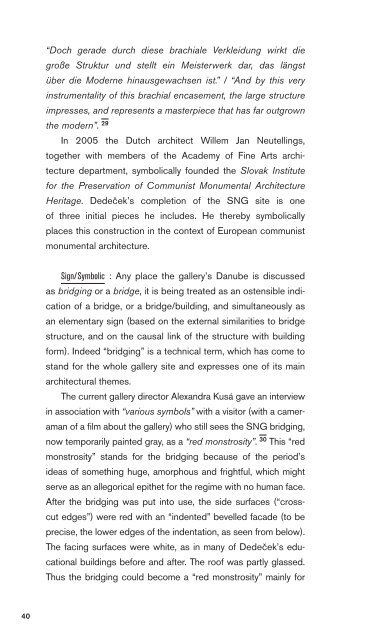sng_2016-05-12_high-single-crop_k3
Create successful ePaper yourself
Turn your PDF publications into a flip-book with our unique Google optimized e-Paper software.
“Doch gerade durch diese brachiale Verkleidung wirkt die<br />
große Struktur und stellt ein Meisterwerk dar, das längst<br />
über die Moderne hinausgewachsen ist.” / “And by this very<br />
instrumentality of this brachial encasement, the large structure<br />
impresses, and represents a masterpiece that has far outgrown<br />
the modern”. 29<br />
In 20<strong>05</strong> the Dutch architect Willem Jan Neutellings,<br />
together with members of the Academy of Fine Arts architecture<br />
department, symbolically founded the Slovak Institute<br />
for the Preservation of Communist Monumental Architecture<br />
Heritage. Dedeček’s completion of the SNG site is one<br />
of three initial pieces he includes. He thereby symbolically<br />
places this construction in the context of European communist<br />
monumental architecture.<br />
Sign/Symbolic : Any place the gallery’s Danube is discussed<br />
as bridging or a bridge, it is being treated as an ostensible indication<br />
of a bridge, or a bridge/building, and simultaneously as<br />
an elementary sign (based on the external similarities to bridge<br />
structure, and on the causal link of the structure with building<br />
form). Indeed “bridging” is a technical term, which has come to<br />
stand for the whole gallery site and expresses one of its main<br />
architectural themes.<br />
The current gallery director Alexandra Kusá gave an interview<br />
in association with “various symbols” with a visitor (with a cameraman<br />
of a film about the gallery) who still sees the SNG bridging,<br />
now temporarily painted gray, as a “red monstrosity”. 30 This “red<br />
monstrosity” stands for the bridging because of the period’s<br />
ideas of something huge, amorphous and frightful, which might<br />
serve as an allegorical epithet for the regime with no human face.<br />
After the bridging was put into use, the side surfaces (“crosscut<br />
edges”) were red with an “indented” bevelled facade (to be<br />
precise, the lower edges of the indentation, as seen from below).<br />
The facing surfaces were white, as in many of Dedeček’s educational<br />
buildings before and after. The roof was partly glassed.<br />
Thus the bridging could become a “red monstrosity” mainly for<br />
40



